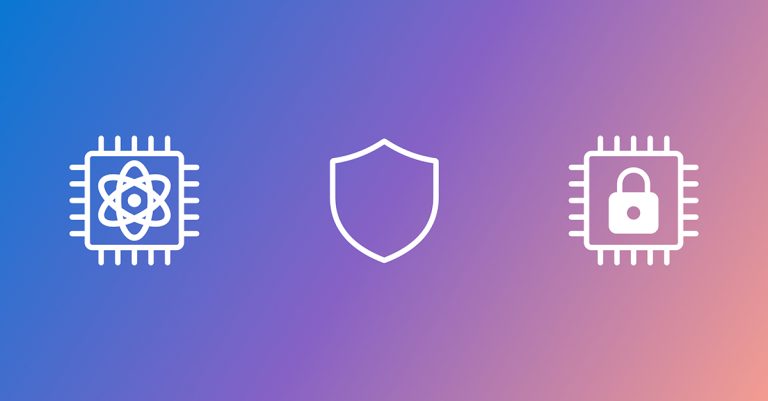
In this post, we describe FrodoKEM, a key encapsulation protocol that offers a simple design and provides strong security guarantees even in a future with powerful quantum computers.
The quantum threat to cryptography
For decades, modern cryptography has relied on mathematical problems that are practically impossible for classical computers to solve without a secret key. Cryptosystems like RSA, Diffie-Hellman key-exchange, and elliptic curve-based schemes—which rely on the hardness of the integer factorization and (elliptic curve) discrete logarithm problems—secure communications on the internet, banking transactions, and even national security systems. However, the emergence of quantum computing poses a significant threat to these cryptographic schemes.
Quantum computers leverage the principles of quantum mechanics to perform certain calculations exponentially faster than classical computers. Their ability to solve complex problems, such as simulating molecular interactions, optimizing large-scale systems, and accelerating machine learning, is expected to have profound and beneficial implications for fields ranging from chemistry and material science to artificial intelligence.
Microsoft research podcast
Collaborators: Silica in space with Richard Black and Dexter Greene
College freshman Dexter Greene and Microsoft research manager Richard Black discuss how technology that stores data in glass is supporting students as they expand earlier efforts to communicate what it means to be human to extraterrestrials.
At the same time, quantum computing is poised to disrupt cryptography. In particular, Shor’s algorithm, a quantum algorithm developed in 1994, can efficiently factor large numbers and compute discrete logarithms—the very problems that underpin the security of RSA, Diffie-Hellman, and elliptic curve cryptography. This means that once large-scale, fault-tolerant quantum computers become available, public-key protocols based on RSA, ECC, and Diffie-Hellman will become insecure, breaking a sizable portion of the cryptographic backbone of today’s digital world. Recent advances in quantum computing, such as Microsoft’s Majorana 1 (opens in new tab), the first quantum processor powered by topological qubits, represent major steps toward practical quantum computing and underscore the urgency of transitioning to quantum-resistant cryptographic systems.
To address this looming security crisis, cryptographers and government agencies have been working on post-quantum cryptography (PQC)—new cryptographic algorithms that can resist attacks from both classical and quantum computers.
The NIST Post-Quantum Cryptography Standardization effort
In 2017, the U.S. National Institute of Standards and Technology (NIST) launched the Post-Quantum Cryptography Standardization project (opens in new tab) to evaluate and select cryptographic algorithms capable of withstanding quantum attacks. As part of this initiative, NIST sought proposals for two types of cryptographic primitives: key encapsulation mechanisms (KEMs)—which enable two parties to securely derive a shared key to establish an encrypted connection, similar to traditional key exchange schemes—and digital signature schemes.
This initiative attracted submissions from cryptographers worldwide, and after multiple evaluation rounds, NIST selected CRYSTALS-Kyber, a KEM based on structured lattices, and standardized it as ML-KEM (opens in new tab). Additionally, NIST selected three digital signature schemes: CRYSTALS-Dilithium, now called ML-DSA; SPHINCS+, now called SLH-DSA; and Falcon, now called FN-DSA.
While ML-KEM provides great overall security and efficiency, some governments and cryptographic researchers advocate for the inclusion and standardization of alternative algorithms that minimize reliance on algebraic structure. Reducing algebraic structure might prevent potential vulnerabilities and, hence, can be considered a more conservative design choice. One such algorithm is FrodoKEM.
International standardization of post-quantum cryptography
Beyond NIST, other international standardization bodies have been actively working on quantum-resistant cryptographic solutions. The International Organization for Standardization (ISO) is leading a global effort to standardize additional PQC algorithms. Notably, European government agencies—including Germany’s BSI (opens in new tab), the Netherlands’ NLNCSA and AIVD (opens in new tab), and France’s ANSSI (opens in new tab)—have shown strong support for FrodoKEM, recognizing it as a conservative alternative to structured lattice-based schemes.
As a result, FrodoKEM is undergoing standardization at ISO. Additionally, ISO is standardizing ML-KEM and a conservative code-based KEM called Classic McEliece. These three algorithms are planned for inclusion in ISO/IEC 18033-2:2006 as Amendment 2 (opens in new tab).
What is FrodoKEM?
FrodoKEM is a key encapsulation mechanism (KEM) based on the Learning with Errors (LWE) problem, a cornerstone of lattice-based cryptography. Unlike structured lattice-based schemes such as ML-KEM, FrodoKEM is built on generic, unstructured lattices, i.e., it is based on the plain LWE problem.
Why unstructured lattices?
Structured lattice-based schemes introduce additional algebraic properties that could potentially be exploited in future cryptanalytic attacks. By using unstructured lattices, FrodoKEM eliminates these concerns, making it a safer choice in the long run, albeit at the cost of larger key sizes and lower efficiency.
It is important to emphasize that no particular cryptanalytic weaknesses are currently known for recommended parameterizations of structured lattice schemes in comparison to plain LWE. However, our current understanding of the security of these schemes could potentially change in the future with cryptanalytic advances.
Lattices and the Learning with Errors (LWE) problem
Lattice-based cryptography relies on the mathematical structure of lattices, which are regular arrangements of points in multidimensional space. A lattice is defined as the set of all integer linear combinations of a set of basis vectors. The difficulty of certain computational problems on lattices, such as the Shortest Vector Problem (SVP) and the Learning with Errors (LWE) problem, forms the basis of lattice-based schemes.
The Learning with Errors (LWE) problem
The LWE problem is a fundamental hard problem in lattice-based cryptography. It involves solving a system of linear equations where some small random error has been added to each equation, making it extremely difficult to recover the original secret values. This added error ensures that the problem remains computationally infeasible, even for quantum computers. Figure 1 below illustrates the LWE problem, specifically, the search version of the problem.
As can be seen in Figure 1, for the setup of the problem we need a dimension \(n\) that defines the size of matrices, a modulus \(q\) that defines the value range of the matrix coefficients, and a certain error distribution \(\chi\) from which we sample \(\textit{“small”}\) matrices. We sample two matrices from \(\chi\), a small matrix \(\text{s}\) and an error matrix \(\text{e}\) (for simplicity in the explanation, we assume that both have only one column); sample an \(n \times n\) matrix \(\text{A}\) uniformly at random; and compute \(\text{b} = \text{A} \times \text{s} + \text{e}\). In the illustration, each matrix coefficient is represented by a colored square, and the “legend of coefficients” gives an idea of the size of the respective coefficients, e.g., orange squares represent the small coefficients of matrix \(\text{s}\) (small relative to the modulus \(q\)). Finally, given \(\text{A}\) and \(\text{b}\), the search LWE problem consists in finding \(\text{s}\). This problem is believed to be hard for suitably chosen parameters (e.g., for dimension \(n\) sufficiently large) and is used at the core of FrodoKEM.
In comparison, the LWE variant used in ML-KEM—called Module-LWE (M-LWE)—has additional symmetries, adding mathematical structure that helps improve efficiency. In a setting similar to that of the search LWE problem above, the matrix \(\text{A}\) can be represented by just a single row of coefficients.

LWE is conjectured to be quantum-resistant, and FrodoKEM’s security is directly tied to its hardness. In other words, cryptanalysts and quantum researchers have not been able to devise an efficient quantum algorithm capable of solving the LWE problem and, hence, FrodoKEM. In cryptography, absolute security can never be guaranteed; instead, confidence in a problem’s hardness comes from extensive scrutiny and its resilience against attacks over time.
How FrodoKEM Works
FrodoKEM follows the standard paradigm of a KEM, which consists of three main operations—key generation, encapsulation, and decapsulation—performed interactively between a sender and a recipient with the goal of establishing a shared secret key:
- Key generation (KeyGen), computed by the recipient
- Generates a public key and a secret key.
- The public key is sent to the sender, while the private key remains secret.
- Encapsulation (Encapsulate), computed by the sender
- Generates a random session key.
- Encrypts the session key using the recipient’s public key to produce a ciphertext.
- Produces a shared key using the session key and the ciphertext.
- The ciphertext is sent to the recipient.
- Decapsulation (Decapsulate), computed by the recipient
- Decrypts the ciphertext using their secret key to recover the original session key.
- Reproduces the shared key using the decrypted session key and the ciphertext.
The shared key generated by the sender and reconstructed by the recipient can then be used to establish secure symmetric-key encryption for further communication between the two parties.
Figure 2 below shows a simplified view of the FrodoKEM protocol. As highlighted in red, FrodoKEM uses at its core LWE operations of the form “\(\text{b} = \text{A} \times \text{s} + \text{e}\)”, which are directly applied within the KEM paradigm.

Performance: Strong security has a cost
Not relying on additional algebraic structure certainly comes at a cost for FrodoKEM in the form of increased protocol runtime and bandwidth. The table below compares the performance and key sizes corresponding to the FrodoKEM level 1 parameter set (variant called “FrodoKEM-640-AES”) and the respective parameter set of ML-KEM (variant called “ML-KEM-512”). These parameter sets are intended to match or exceed the brute force security of AES-128. As can be seen, the difference in speed and key sizes between FrodoKEM and ML-KEM is more than an order of magnitude. Nevertheless, the runtime of the FrodoKEM protocol remains reasonable for most applications. For example, on our benchmarking platform clocked at 3.2GHz, the measured runtimes are 0.97 ms, 1.9 ms, and 3.2 ms for security levels 1, 2, and 3, respectively.
For security-sensitive applications, a more relevant comparison is with Classic McEliece, a post-quantum code-based scheme also considered for standardization. In this case, FrodoKEM offers several efficiency advantages. Classic McEliece’s public keys are significantly larger—well over an order of magnitude greater than FrodoKEM’s—and its key generation is substantially more computationally expensive. Nonetheless, Classic McEliece provides an advantage in certain static key-exchange scenarios, where its high key generation cost can be amortized across multiple key encapsulation executions.

A holistic design made with security in mind
FrodoKEM’s design principles support security beyond its reliance on generic, unstructured lattices to minimize the attack surface of potential future cryptanalytic threats. Its parameters have been carefully chosen with additional security margins to withstand advancements in known attacks. Furthermore, FrodoKEM is designed with simplicity in mind—its internal operations are based on straightforward matrix-vector arithmetic using integer coefficients reduced modulo a power of two. These design decisions facilitate simple, compact and secure implementations that are also easier to maintain and to protect against side-channel attacks.
Conclusion
After years of research and analysis, the next generation of post-quantum cryptographic algorithms has arrived. NIST has chosen strong PQC protocols that we believe will serve Microsoft and its customers well in many applications. For security-sensitive applications, FrodoKEM offers a secure yet practical approach for post-quantum cryptography. While its reliance on unstructured lattices results in larger key sizes and higher computational overhead compared to structured lattice-based alternatives, it provides strong security assurances against potential future attacks. Given the ongoing standardization efforts and its endorsement by multiple governmental agencies, FrodoKEM is well-positioned as a viable alternative for organizations seeking long-term cryptographic resilience in a post-quantum world.
Further Reading
For those interested in learning more about FrodoKEM, post-quantum cryptography, and lattice-based cryptography, the following resources provide valuable insights:



